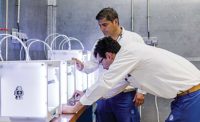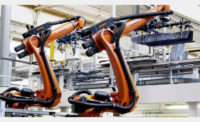Although a global leader in mechanical and plant engineering, Dürr AG isn’t one to rest on its laurels. So in 2010 it acquired two adhesive technology companies (Rickert and Kleinmichel) to increase Dürr’s expertise in automotive body-in-white gluing technology.
The merged companies are now known as Dürr Systems Wolfsburg GmbH, which is part of the application technology division. In April 2013, this subsidiary contracted with the Volkswagen Group to install 520 automatic gluing systems at Audi plants in Ingolstadt and Neckarsulm, Germany, and the VW plant in Bratislava, Slovakia, by the end of 2014. Many systems have been in operation for nearly a year.
When all the systems are installed, nearly half will apply short beads of adhesive to insulate, seal and join body panels on the Audi A4, A5 and Q7 models. Short-bead technology is used in conjunction with weld bonding, a process that combines spot welding and adhesive bonding.
Volkswagen likes short-bead technology because, unlike conventional welding, it is suitable for panels made of sheet metal or carbon fiber composites. This technology also provides high-strength bonding, reduces body construction cycle time and improves the body’s crash safety performance.
System components include an application head, adhesive pump and control software that enables Audi engineers to review all bonding process operations in advance through simulation.
A servo drive opens and closes the application head very quickly to dispense short beads of adhesive, and a robot precisely positions each bead. Spot welds are applied in the gaps between beads without burning the adhesive.
Another Dürr system increasing in popularity among European and Chinese automakers is Ecopaint Gluing. It is used for semi or fully automated bonding of automobile windows, window glazing, roof modules, roof-reinforcement dampings and plastic components.
Highly viscous glue is applied either to an installed component by a mobile robot-mounted applicator, or to a mobile component by a stationary robot-mounted applicator. In the latter process, another robot places the treated component into a corresponding body section. All robot movements are vision guided.
The surface is pretreated with a primer or activator that is applied by spray, paintbrush or felt. Glue is stored in 200-liter barrel pumps, preheated up to 80 C and accurately dispensed from single or double EcoShot Meter devices.
Each device is electrically driven for continuous volume control. It holds 110 cc and has a material volume flow up to 35 cc per second.
For more information on body-in-white gluing technologies, call 248-745-8500 or visit www.durr.com.





